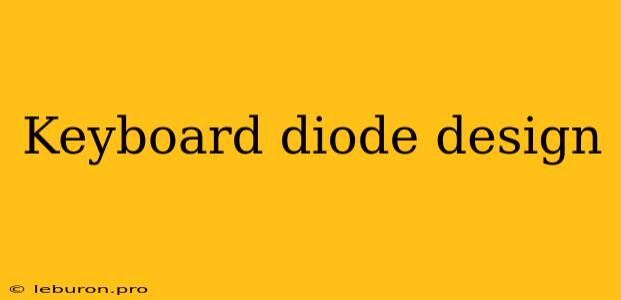The design of a keyboard diode is a crucial aspect of ensuring proper signal transmission and preventing unwanted crosstalk between keys. Diodes are essential components that allow current to flow in one direction only, effectively isolating the individual key switches from each other. This article delves into the intricacies of keyboard diode design, exploring the key considerations, different diode types, and the impact of their selection on keyboard performance.
Understanding Keyboard Diodes
Role of Diodes in Keyboard Functionality
A keyboard relies on individual key switches to generate signals when pressed. Each key switch essentially acts as a simple switch, closing a circuit when the key is pressed. When multiple keys are pressed simultaneously, it's possible for signals from one key to interfere with the signals from another. To prevent this, diodes are strategically placed in the keyboard's circuit. These diodes create one-way paths for the signals, ensuring that each key press is independently detected.
Key Considerations in Keyboard Diode Design
Several key factors influence the choice of diodes for a keyboard:
- Forward Voltage Drop: The forward voltage drop across a diode determines how much voltage is lost when current flows through it. A lower forward voltage drop is desirable, minimizing voltage loss and ensuring reliable signal transmission.
- Reverse Leakage Current: This parameter indicates the amount of current that flows through the diode in the reverse direction. A low reverse leakage current is essential to minimize unwanted signal interference and crosstalk.
- Switching Speed: The speed at which a diode can switch between conducting and non-conducting states is crucial for fast keyboard responsiveness. A high switching speed ensures accurate signal detection for rapid keystrokes.
- Current Rating: The diode must be able to handle the current flowing through the keyboard circuit without overheating or failing. Choosing a diode with a sufficient current rating is essential for long-term reliability.
Types of Diodes for Keyboard Applications
Several diode types are commonly employed in keyboard designs:
- 1N4148 Diodes: These are popular choices due to their low cost, low forward voltage drop, and relatively fast switching speed. They are suitable for general-purpose keyboard applications.
- Schottky Diodes: Schottky diodes offer lower forward voltage drops compared to 1N4148s, making them suitable for applications where minimizing voltage loss is crucial. However, they may have slightly higher reverse leakage currents.
- Ultra-Fast Diodes: For keyboards requiring exceptional responsiveness and high-speed signal transmission, ultra-fast diodes are preferred. These diodes have extremely fast switching speeds but can be more expensive.
Impact of Diode Selection on Keyboard Performance
The selection of diodes significantly impacts the performance and overall user experience of a keyboard:
- Signal Clarity: Choosing diodes with low reverse leakage current and fast switching speeds enhances signal clarity, minimizing crosstalk and ensuring accurate signal detection.
- Responsiveness: Ultra-fast diodes contribute to improved keyboard responsiveness, allowing for rapid keystrokes without signal delays.
- Durability: Diodes with sufficient current ratings and low forward voltage drop contribute to increased keyboard durability by minimizing stress on the components and ensuring reliable performance over time.
Diode Placement and Circuitry
Matrix Layout and Diode Placement
The arrangement of diodes in a keyboard circuit is essential for isolating each key switch. A common approach is using a matrix layout, where rows and columns of keys are interconnected with diodes. When a key is pressed, the diode allows current to flow only in the corresponding row and column, generating a unique signal.
Diode-Clamped Key Switches
In some keyboard designs, diodes are directly connected to the key switches. This approach, known as diode-clamped key switches, provides a more robust and compact design. However, it requires careful consideration of the diode's characteristics and compatibility with the specific key switch.
Alternative Diode Configurations
Various alternative diode configurations exist, each offering unique advantages and disadvantages. Some popular alternatives include:
- Dual Diode Configuration: Utilizing two diodes per key switch can enhance signal clarity and reduce crosstalk.
- Zener Diode Configuration: Zener diodes can be used to regulate the voltage applied to the key switches, improving signal stability.
Considerations for Custom Keyboard Builders
For custom keyboard builders, selecting the right diodes is essential for achieving optimal keyboard performance:
- Compatibility: Ensure compatibility between the chosen diodes and the keyboard layout, key switches, and controller.
- Availability: Certain diode types may be difficult to procure or have limited availability, so plan accordingly.
- Cost: Consider the cost of diodes, especially for larger keyboard projects.
Benefits of Choosing High-Quality Diodes
Investing in high-quality diodes offers several benefits:
- Improved Responsiveness: Fast switching speeds and low voltage drop enhance keyboard responsiveness.
- Reduced Crosstalk: Minimizing reverse leakage current reduces unwanted crosstalk, ensuring signal clarity.
- Enhanced Durability: Choosing diodes with suitable current ratings contributes to the long-term durability of the keyboard.
Conclusion
The careful selection and design of keyboard diodes are essential for achieving optimal performance and responsiveness. Understanding the key considerations, different diode types, and the impact of their selection on keyboard performance is crucial for custom keyboard builders and anyone interested in maximizing their keyboard's functionality. By investing in high-quality diodes and implementing proper diode placement, you can enjoy a more reliable, responsive, and enjoyable keyboard experience. Keyboard diode design plays a vital role in transforming the keyboard into a seamless extension of your creative endeavors.
